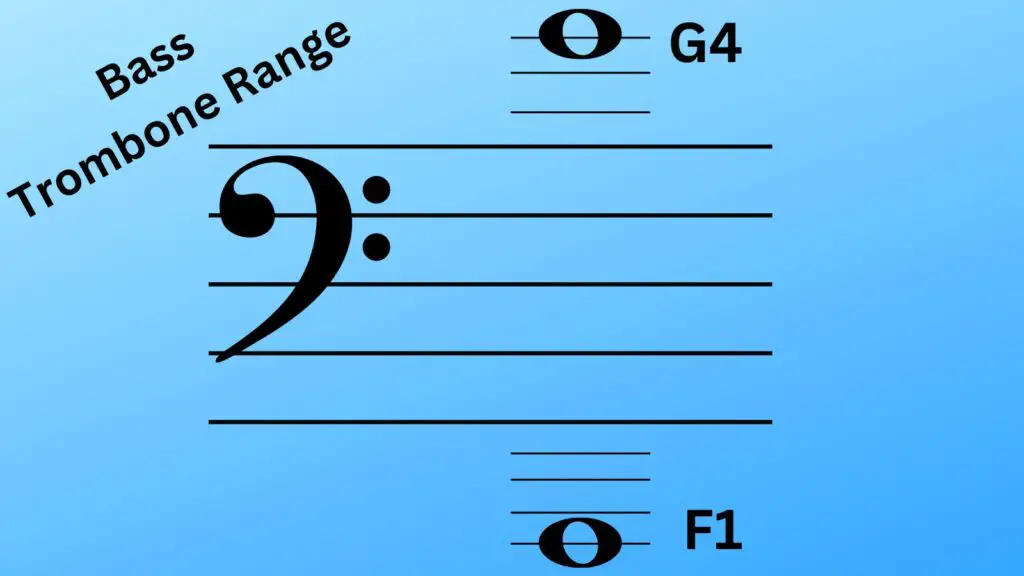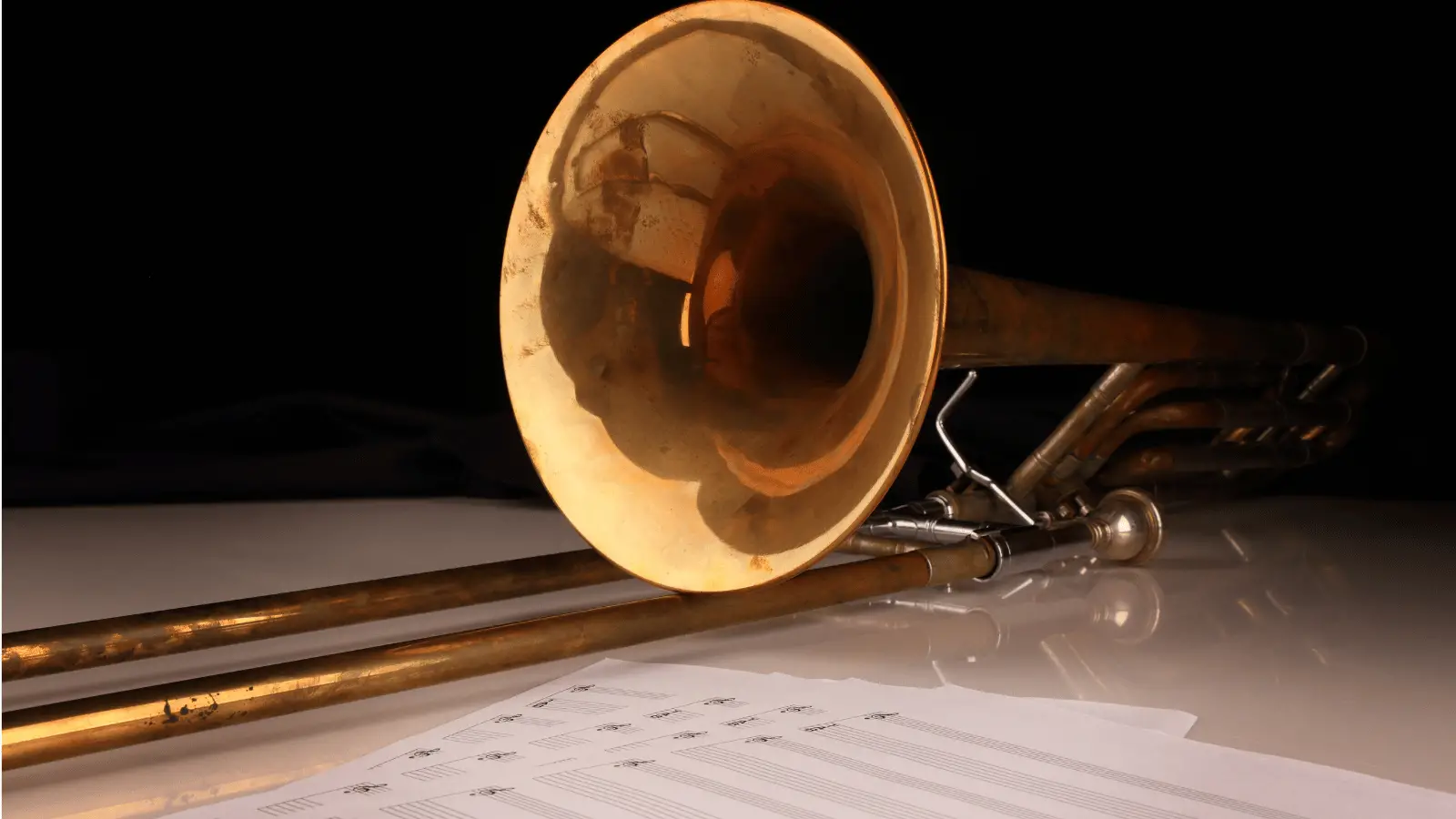The bass trombone, a brass instrument known for its rich and powerful sound, offers a wide range of musical possibilities.
Understanding and mastering the bass trombone’s range is essential for players to fully express themselves and excel in various musical genres.
In this article, we will explore the different aspects of the bass trombone range, including its low and high registers, techniques for playing in different ranges, and its musical applications.
Whether you’re a beginner or an experienced player, this article will provide valuable insights and practical tips to help you unlock the full potential of the bass trombone’s range.
Table of Contents
What Is The Bass Trombone’s Range?

The bass trombone has a wide range that spans across multiple octaves.
The exact range of the bass trombone can vary depending on factors such as the player’s skill level, instrument setup, and musical context.
However, a typical range for a bass trombone in B-flat or F might be from Bb1 (the pedal Bb) to approximately F4 or G4 above the bass clef staff, although some advanced players may be able to play even higher.
Understanding the Bass Trombone Range
The bass trombone’s range spans across multiple octaves, encompassing both low and high registers.
In its low register, the bass trombone is capable of producing rich and resonant pedal tones, which are fundamental pitches that create a strong foundation for the ensemble.
These pedal tones are produced by extending the slide to the lower positions and using proper breath control and embouchure technique.
In the high register, the bass trombone can produce bright and vibrant tones that can cut through the ensemble, adding a sense of excitement and brilliance to the music.
Players achieve the high range by using shorter slide positions and employing different techniques, such as lip slurs and alternate positions, to navigate the smaller intervals.
Techniques for Playing in the Bass Trombone Range:
Mastering the bass trombone range requires specific techniques that can help players achieve accurate intonation, smooth transitions, and varied tonal effects.
Proper embouchure, breath control, and slide technique are crucial for playing in both the low and high registers.
In the low register, players need to focus on maintaining a relaxed embouchure and controlling their breath to produce clear and resonant pedal tones.
The use of alternate positions and careful slide control can also facilitate smoother transitions between pedal tones and other notes.
In the high register, players need to develop a strong and flexible embouchure to produce clear and controlled tones.
Lip slurs, which involve changing the pitch by altering the tension of the lips while keeping the air flowing, are essential for navigating the smaller intervals in the high range.
Alternate slide positions, such as using the F-attachment or trigger, can also extend the range and enable players to play higher/lower notes with more accuracy.
Additionally, techniques such as glissandos, harmonics, and muting can be employed to create unique tonal effects and add expressive elements to the bass trombone playing in different ranges.
However, players should be mindful of potential challenges, such as intonation issues, reduced stability in extreme registers, and increased physical demands on embouchure and breath control.
Quick Tips For Playing Lower
- Maintain a relaxed embouchure to produce clear and resonant pedal tones.
- Focus on proper breath control, using diaphragmatic breathing, to support the lower notes.
- Use a consistent air flow and avoid overblowing, which can result in a fuzzy or distorted sound.
- Pay attention to slide control and intonation, as lower notes can be more sensitive to pitch accuracy.
- Practice long tones and pedal tone exercises to develop control and stability in the lower register.
- Experiment with different slide positions and alternate fingerings to find the best intonation for each note.
- Practice playing legato and staccato in the lower register to develop control and articulation.
- Warm up thoroughly before playing in the lower register to avoid strain or tension in the lips and muscles.
- Listen to recordings of bass trombone players to develop a sense of tone and style in the lower register.
Quick Tips For Playing Higher
- Develop a strong and flexible embouchure to produce clear and controlled tones in the higher register.
- Practice lip slurs regularly to improve accuracy and speed in playing higher notes.
- Keep the air flowing smoothly and consistently, using proper breath control, to support the higher register tones.
- Use lighter articulation and faster airspeed to achieve clear and focused tones in the higher register.
- Focus on slide technique, using shorter slide positions and precise movements for accurate pitch control in the higher register.
- Experiment with different mouthpiece* sizes and styles to find the one that best suits your playing style and helps facilitate playing in the higher register.
- Practice regularly and consistently, dedicating specific practice time to working on high range playing to build strength and endurance.
- Seek guidance from a qualified trombone teacher or mentor for personalized feedback and tips on playing higher on the trombone.
*Check out our deep-dive review of the best trombone mouthpieces for every situation.
Musical Applications of the Bass Trombone Range
The bass trombone’s versatile range finds its applications in various musical genres and styles.
In jazz music, the bass trombone often serves as a critical component of the rhythm section, providing deep and resonant bass lines or playing expressive solos in the higher register.
In orchestral music, the bass trombone is commonly used to provide a solid foundation in the low register, add color and depth to ensemble passages, or play challenging melodic lines in the high register.
Contemporary compositions may also feature the bass trombone’s range to create unique and experimental effects.
Notable composers such as Gustav Mahler, Richard Strauss, and John Williams have written significant works that showcase the bass trombone’s range and versatility.
Famous Examples Of Bass Trombone Playing
- “Symphonie Fantastique” by Hector Berlioz
- “Rite of Spring” by Igor Stravinsky
- “Pictures at an Exhibition” by Modest Mussorgsky
- “Symphony No. 4” by Gustav Mahler
- “Bolero” by Maurice Ravel
- “Till Eulenspiegel’s Merry Pranks” by Richard Strauss
- “Symphony No. 1” by Johannes Brahms
- “Pines of Rome” by Ottorino Respighi
- “Symphony No. 5” by Dmitri Shostakovich
- “Symphony No. 9” by Ludwig van Beethoven
- “La Follia” by Antonio Vivaldi
- “The Planets” by Gustav Holst
- “Firebird Suite” by Igor Stravinsky
- “Ein Heldenleben” by Richard Strauss


